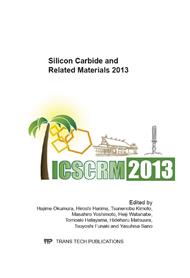[1]
J. Rabkowski, D. Peftitsis, and H. -P. Nee, Silicon Carbide Power Transistors - A New Era in Power Electronics is Initiated, Industrial Electronics Magazine, vol. 6, June 2012, pp.17-26.
DOI: 10.1109/mie.2012.2193291
Google Scholar
[2]
J. Biela, M. Schweizer, S. Waffler, and J.W. Kolar, SiC versus Si – Evaluation of Potentials for Performance Improvement of Inverter and DC–DC Converter Systems by SiC Power Semiconductors, IEEE Trans. On Ind. Electron., vol. 58, no. 7, p.2872–2882, July (2011).
DOI: 10.1109/tie.2010.2072896
Google Scholar
[3]
B. Ållebrand and H. -P. Nee, On the possibility to use SiC JFETs in Power Electronic circuits, Proc. of the European Conference on Power Electronics and Applications (EPE), Graz, Austria, August (2001).
Google Scholar
[4]
B. Ållebrand and H. -P. Nee, On the choice of blanking times at turn-on and turn-off for the diode-less SiC JFET inverter bridge, Proc. of the European Conference on Power Electronics and Applications (EPE), Graz, Austria, August (2001).
Google Scholar
[5]
R. Shillington, P. Gaynor, M. Harrison, and W. Heffernan, Silicon carbide JFET reverse conduction characteristics, IET Power Electronics, 2012, vol. 5, Iss. 8, p.1282–1290.
DOI: 10.1049/iet-pel.2011.0404
Google Scholar
[6]
D. Peftitsis, J. Rabkowski, and H. -P. Nee, Self-powered gate driver for normally on silicon carbide junction field-effect transistors without external power supply, IEEE Trans. On Power Electron., vol. 28, no. 3, p.1488–1501, March (2013).
DOI: 10.1109/tpel.2012.2209185
Google Scholar
[7]
J. Rabkowski, G. Tolstoy, D. Peftitsis, and H. -P. Nee, Low-Loss High-Performance Base-Drive Unit for SiC BJTs, vol. 27, no. 5, pp.2633-2643, May (2012).
DOI: 10.1109/tpel.2011.2171722
Google Scholar
[8]
G. Tolstoy, D. Peftitsis, J. Rabkowski, H. -P. Nee, and P.R. Palmer, Discretized Proportional Base Driver for Silicon Carbide Bipolar Junction Transistors, Proc. of ECCE ASIA 2013, Melbourne, 4-6 June (2013).
DOI: 10.1109/ecce-asia.2013.6579182
Google Scholar
[9]
J. Rabkowski, D. Peftitsis, and H. -P. Nee, Design Steps Toward a 40-kVA SiC JFET Inverter With Natural-Convection Cooling and an Efficiency Exceeding 99. 5%, IEEE Trans. on Ind. Appl., vol. 49, no. 4, pp.1589-1598, July/August (2013).
DOI: 10.1109/tia.2013.2258132
Google Scholar
[10]
J. Colmenares, D. Peftitsis, J. Rabkowski, H. -P Nee, Dual-Function Gate Driver for a Power Module With SiC Junction Field-Effect Transistors, Proc. of IEEE ECCE ASIA 2013, Melbourne.
DOI: 10.1109/ecce-asia.2013.6579104
Google Scholar
[11]
J. Rabkowski, D. Peftitsis, M. Zdanowski, H. -P. Nee, A 6 kW, 200 kHz Boost Converter with Parallel-Connected SiC Bipolar Transistors, Proc. of IEEE Applied Power Electronics Conference and Exposition 2013, APEC 2013, March (2013).
DOI: 10.1109/apec.2013.6520568
Google Scholar
[12]
A. Lesnicar and R. Marquardt, An innovative modular multilevel converter topology suitable for a wide power range, Proc. IEEE Bologna Power Tech, 2012, vol. 3, (2003).
DOI: 10.1109/ptc.2003.1304403
Google Scholar
[13]
D. Peftitsis, G. Tolstoy, A. Antonopoulos, J. Rabkowski, J. -K. Lim, M. Bakowski, L. Ängquist, and H. -P. Nee, High-Power Modular Multilevel Converters With SiC JFETs, IEEE Transactions on Power Electronics, vol. 27, no. 1, January 2012, pp.28-36.
DOI: 10.1109/tpel.2011.2155671
Google Scholar


